Peculiarities
Content
The national Chechen wedding dress traditionally consists of 4 original parts:
- Modest, laconic underdress (shirt/tunic). Length - ankle length. The cut is narrow to the waist, slightly flared at the bottom, with light, flowing pleats. A mandatory element is a stand-up collar with a tiny button. The sleeves are very long, reaching literally to the fingertips. The decoration of the lower dress was a silver, gold or stone-covered bib, which later began to be made in the form of clasps.
- Richly decorated outer dress. The cut is similar to a robe or caftan. Without a collar, with a slit on the chest, with small hooks at the waist, in order to unobtrusively emphasize her grace. Due to the halves diverging to the sides, the skirt resembles two delicate flower petals. The image of the bride is graceful and eye-catching.
- Headdress. Traditionally this is a scarf or lace shawl. Its significance for the Chechen woman is enormous, because such a product symbolizes chastity, purity, and modesty.
- Belt made of real silver. The central detail of the overall ensemble. Should be richly decorated. Traditionally, this element was passed down from generation to generation or given by the groom to his future wife immediately before the wedding.
Today, it is a common practice for brides at a wedding to wear an outfit that combines the features of a national costume and lush wedding silhouettes in snow-white or pastel colors.
Such Chechen wedding dresses harmoniously intertwine a number of distinctive features, which together create models that are unique in beauty and design:
- Coverage of the outfit: long sleeves, high collar, maximum length of the skirt, hiding even shoes. Chechen girls never show naked parts of their bodies to prying eyes. This style of behavior is reflected in the cut of the traditional suit. Despite all these features, the image of the newlywed turns out to be mysterious, feminine, and elegant.
- Long train. Everything is simple here: the longer it is, the richer and more impressive the model looks.
- Richness of decor. A wedding dress must be embroidered with gold and silver threads, decorated with precious stones, pearls, and beads. The most expensive and beautiful fabrics are used: brocade, velvet, silk, satin, morocco.
Caucasian weddings
Features of traditions at Caucasian weddings
Caucasian weddings have some significant differences from similar ceremonies among other nations.
Wedding Hiding
In the Middle Ages, despite the fact that the newlyweds were the main participants in the wedding ceremony, they were not present at the celebration together. During the entire wedding celebration, the bride and groom hid from each other and celebrated their own wedding with their relatives. The opportunity for the newlyweds to look at each other was provided only before their wedding night. This tradition reinforced the division of society into female and male, accepted in the Caucasus.
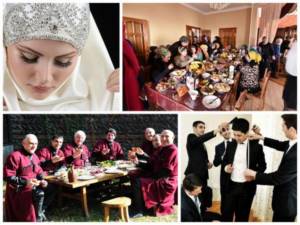
Entering the husband's house
The most striking event of a Caucasian wedding celebration was the entry of the young wife into her husband’s house. The newlywed did this with her face covered to avoid the evil eye and attacks from evil spirits. Traditionally, a sheep's skin was placed on the threshold of the house. The young wife had to cross the threshold of her new home only with her right foot, breaking a small saucer in the process. The belief was that following this ritual would bring the newlyweds a happy and peaceful family life.
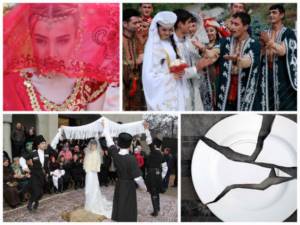
Embrace
Before the newlyweds left for the bedroom, a hug ritual was performed. The girl was hugging close relatives. The first, according to tradition, was to be hugged by a boy or girl with a baby in his arms, which promised the birth of a son in a young family. Then the newlywed hugged her grandmother, the eldest woman in the family.
To make the life of a young wife in her husband's house rich and sweet, the mother-in-law gave her a spoonful of honey, and the guests showered the newlywed with sweets, coins, and also rice, which is a symbol of prosperity and fertility.
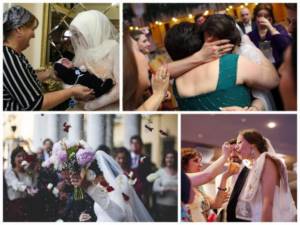
The wedding night
A Caucasian bride meets her future husband before her wedding night. After this, the marriage is considered valid and the ritual of “removing prohibitions” takes place. The newlyweds again get the opportunity to see family and friends from whom they were hiding throughout the wedding celebration.
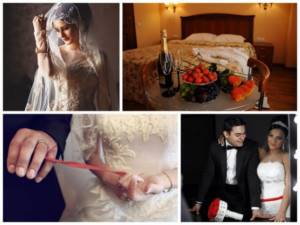
The bride's exit to the river
A very common village tradition is the bride going to the river. In ancient times, people believed that a Caucasian girl could be pulled to the bottom of a river while she was collecting water. To prevent this from happening, it was necessary to carry out a special ritual. The newlywed was led to a pond, where the husband threw a piece of bread as a gift to the waterman. During this ritual, everyone sang songs, music played, and then they shot at the bread donated to the waterman.
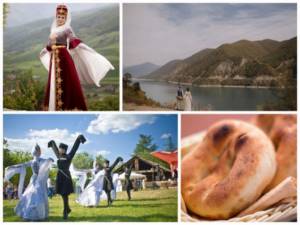
Present
A Caucasian wedding is simply unthinkable without numerous gifts. The bride's family presented the young son-in-law and all the men from his family with warm socks. The gift was a symbol of the future wife's thriftiness.
In modern large cities, many ancient Caucasian rituals have changed or been supplemented with new original details. For example, if previously men and women celebrated weddings separately, now young unmarried girls are present at the wedding celebration, where they have the opportunity to find a groom. Young beauties meticulously prepare for their friend’s wedding - they embroider beautiful outfits to please men, and the guys, in turn, prepare fiery toasts and confessions with which they intend to win the hearts of girls.
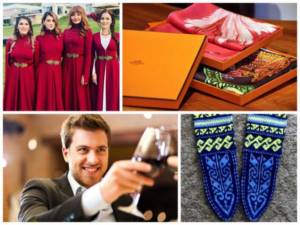
After exchanging friendly phrases, the young horseman tries to treat the girl he likes, thus expressing his sympathy for her. But the Caucasian young man does not present the treat personally, but through an intermediary. If the young lady likes the guy, she, through the same intermediary, gives the candidate an embroidered scarf. The exchange of gifts laid the foundation for future relationships between young people.
Matchmaking in the Caucasus
Before the matchmaking ceremony, a suitable bride was chosen for the horseman. In ancient times, the boy’s parents dealt with this issue. Significant aspects of the choice were: the material wealth of the parents, their status in society, and the health of their daughter. Today, Caucasian grooms have the opportunity to choose their own brides, but in tribute to the traditions of their ancestors, they ask their parents for permission, and only then send matchmakers.
Matchmaking in the Caucasus is divided into two stages:
First stage.
The matchmaker from the groom's family meets with the girl's family and agrees on the day when the entire delegation will arrive to visit, offering to carefully prepare for this time. On the appointed day, people arrive from a Caucasian guy. Usually this is a father, brother, uncle and a person who is respected in the village and who knows both families well. Guests are seated at the table. The bride's father and close relatives come out to them. At first they talk about abstract topics, and then the matchmakers smoothly move on to the purpose of their visit - they ask to marry off their daughter.
It is not customary to give consent to marriage on your first visit. The girl’s father says that they need to think, consult with their relatives and ask their daughter’s opinion, and then give a final answer.
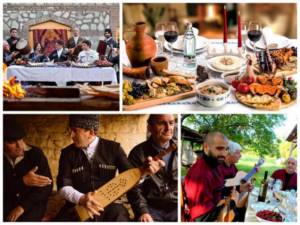
Second phase
takes place on a larger scale, they prepare for it even more seriously than for the first - there are more treats on the table, and there are more ritual participants in the house. The matchmakers are warmly welcomed, and again the guests communicate at first on abstract topics. When the conversation gets to the main point, the matchmaker asks what decision the girl’s family came to. This time, the girl’s father gives consent to the marriage, or gives the reason for the refusal, which happens extremely rarely.
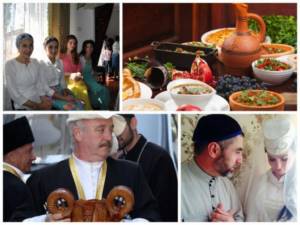
Great Caucasian matchmaking
Each matchmaking largely depends on the cultural heritage and nationality of the peoples living in the Caucasus. Previously, the wedding date of the newlyweds was set by their parents. Over time, this honorable duty fell on the shoulders of the groom, but at the same time, he always asks and takes into account the wishes of the bride. In ancient times, the matchmaking ceremony in the Caucasus took place in the spring, and the wedding celebration in the fall, after the entire harvest had been harvested from the fields. But this tradition has become a thing of the past; weddings began to take place mainly in the summer, in warm weather.
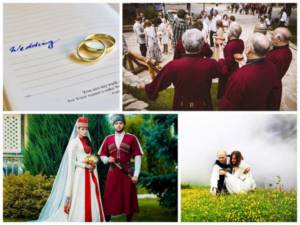
After a successful matchmaking, families agree on the number of invited guests and the amount of money that the future spouse can spend on the wedding. In the Caucasus, it is customary to invite many guests to a celebration. Among them are close and distant relatives, friends, acquaintances, neighbors. If the newlyweds suddenly forget to invite someone to the wedding, this can serve as a serious reason for resentment. Even a stranger can come to the banquet if he gives a good gift to the newlyweds. The uninvited guest will be received warmly and cordially.
There are times when matchmaking goes wrong and the groom is refused. Then, if the highlander is not going to renounce his beloved, he can take extreme measures and kidnap the bride. Together with his friends, a young horseman commits a kidnapping and takes the captive to his house. There he persuades the girl, promises her various gifts and a rich family life. If a Caucasian girl does not want to marry her kidnapper, it is still easier for her to agree to the marriage. Otherwise, after spending the night in the house of a stranger, she is considered disgraced.
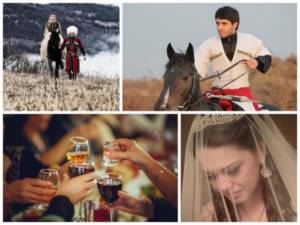
The custom of celebrating two weddings
The wedding feast in the Caucasus lasts several days. In the old days, two banquets took place simultaneously - in the house of the future spouse and in the house of the bride. The wedding of the man and woman was celebrated separately. This separation allowed both parties to feel at ease and comfortable. Then this tradition fell into oblivion.
Today, Caucasian women have more freedom and can celebrate their weddings with men. But, paying tribute to the traditions of their ancestors, the bride's parents should not be present at the celebration. Because of this tradition, the custom has developed in the Caucasus to celebrate two weddings: at the first celebration, which is celebrated a week before the main wedding, the parents say goodbye to their daughter. All the bride’s relatives are also present here: they are having fun, dancing, and singing national songs.
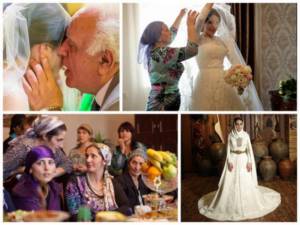
And on the day of the official marriage, the groom’s relatives and friends take up the baton. The girl's parents are paid a bride price, and her friends help the bride transport the dowry to her husband's house, where the young wife is moving. Since two wedding celebrations are quite expensive even for Caucasians, many families now celebrate one wedding, attended by relatives, friends and acquaintances from both sides.
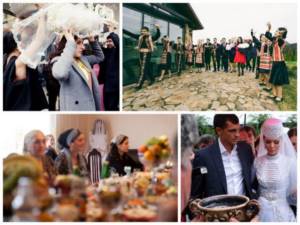
Caucasian bride is a model of chastity and modesty
Mountain residents treat women with great respect, but demand respect and even admiration from them before men. The bride in the Caucasus is always beautiful, modest and innocent. A girl who is getting married must behave quietly and modestly during the holiday, remain silent for the most part, and drink and eat almost nothing. Her face is most often covered with a white cloth. If at wedding ceremonies in other countries, the newlywed actively participates in the celebration, then among the highlanders it serves only as a decoration for the wedding celebration.
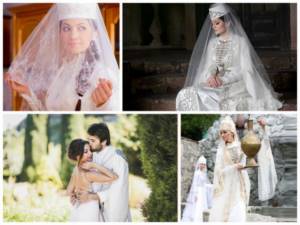
It is customary for Russians to shout “Gorko!” at a wedding. After this call, the newlyweds begin to kiss. It is believed that the longer the kiss lasts, the more joyful and happy the family life will be. You won’t hear “Bitter!” at any Caucasian wedding. and you will not see the kiss of the young. According to national customs, a guy has no right to touch his beloved until his wedding night. Also, at the wedding celebration you will not hear obscene jokes and liberties addressed to the young wife.
Lezginka: music and dancing at Caucasian weddings
If you have ever attended a Caucasian wedding, you have heard lively and cheerful music throughout the entire celebration. During the feast, guests sing national songs and dance. The main Caucasian dance, without which it is impossible to imagine any celebration here, is the Lezginka. The man in it plays the role of an eagle, and the woman – a swan. A Caucasian newlywed can take part in wedding dances, but for this she must be invited by an older relative.
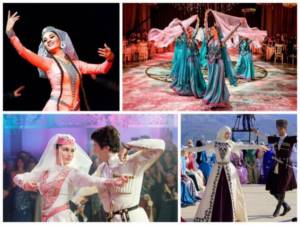
Caucasian toasts for a wedding
Highlanders love to toast, so newlyweds hear a huge number of pleasant words addressed to them during the wedding ceremony. Toasts, as a rule, are long in the form of instructive parables, instructions and advice. When a bright speech is addressed to a newlywed, they praise, first of all, his strength, perseverance and courage. If they praise the bride, they focus on how modest, beautiful, and thrifty she is. Caucasian wedding celebrations are noisy. The belief says that, thanks to a lot of fun, the newlyweds will be happy in their family life.
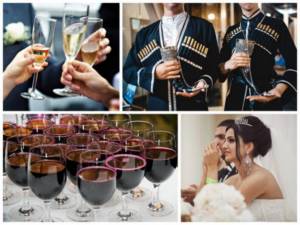
Festive cortege of newlyweds
The cortege of Caucasian newlyweds consists of at least 20 cars. Drivers, honking loudly, inform everyone about the joyful event. The person in charge of the money always rides in the car leading the motorcade. He pays a ransom to everyone who stops cars, even to random passers-by. The bride and groom are traveling in the second car, and in the third car they are carrying carpets that are laid out in front of the young wife so that she does not step on the asphalt with her festive shoes.

Caucasian wedding 2021 video
A Caucasian wedding celebration is an important event, both for the newlyweds and for all relatives and guests. The components of a highlander ceremony are a beautiful bride, a courageous and elegant groom, cheerful guests, songs, toasts and fiery dances. If you are lucky enough to attend a Caucasian wedding, be sure to take photos and videos of the celebration so that you can review the interesting and important moments of this bright event later.
Varieties
Chechen wedding dresses, made in the national style, are dominated by snow-white, milky, beige, and coffee shades. Occasionally you can find pale pink and blue tones.
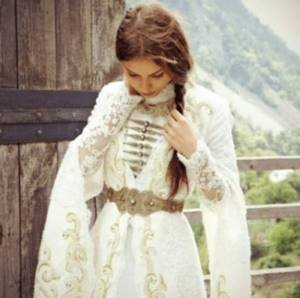
Wedding dresses in this country can be divided into three main groups:
- National wedding attire - bright and original models, fully consistent with the traditions of the Chechens and their conservative views on women's clothing.
- Traditional European closed wedding dresses.
- Unique costumes that combine the first two models. In terms of sophistication and style, they are very similar to the exquisite outfits of French couturiers.
Styles
Wedding dresses must be floor length. Variations of the fluffy dress, the so-called “princess” style, are popular. The bodice in it can be corseted, but must have a high collar and a closed back.
A Greek silhouette of a dress with a high waist and long sleeves is allowed. A luxurious, large train is the main attribute and distinctive feature of the wedding image of a Chechen bride.
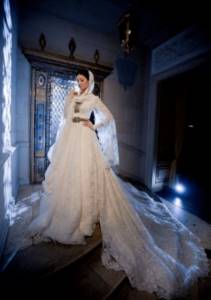
Any style is generously decorated with ethnic gold embroidery, beads, rhinestones, and large stones. The abundance of rich, sparkling decor is a characteristic feature of Chechen wedding attire.
Accessories and shoes
A veil is present in wedding clothing in this country, however, it is often complemented by a luxurious scarf decorated with lace embroidery, a tiara or a characteristic crown. The headdress can be complemented with a veil, so the image of the newlywed turns out to be even more tender and mysterious. A snow-white hijab made from the finest fabrics instead of a traditional veil.
The wedding attire must be accompanied by appropriate shoes. Traditionally, these are luxurious shoes that harmonize in color with the shade of the bride’s outfit. For winter weddings, the option of elegant ankle boots is acceptable.
There should be a lot of jewelry: the abundance of rich decor and hand embroidery on the dress itself and the headdress is complemented by large earrings, rings, and necklaces. A Chechen bride should shine at a wedding, so she demonstrates not only her beauty, but also the degree of wealth of her parents, which is important for this country.
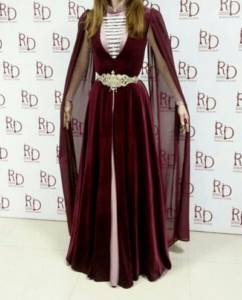
Headdress
The choice of headwear is not so wide. Chechens are not as strict as other Muslims in this matter. They consider it acceptable for a woman to have slightly visible hair. Therefore, one of the options could be a traditional people's hat with a veil. The result will be a more original and varied option.
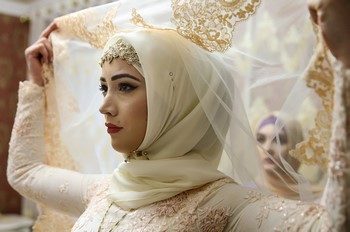
Traditionally, most women prefer to opt for a scarf. It is quite brightly embroidered with threads, rhinestones or beads. There are no controversial issues regarding the decorative finishing of scarves. For the wedding ceremony, girls try to choose the brightest and most colorful options, which allows them to stand out.
Girls dream of a wedding with a veil, so they throw a similar accessory over the scarf. If a Chechen bride has a veil, she always covers her face, which makes the woman’s image more mysterious and enigmatic.










